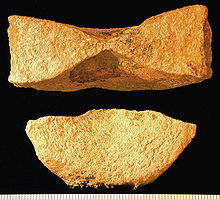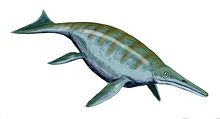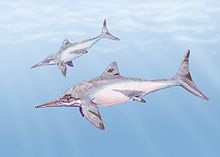
Ichthyosaur
About this schools Wikipedia selection
SOS Children offer a complete download of this selection for schools for use on schools intranets. To compare sponsorship charities this is the best sponsorship link.
| Ichthyosaurs Temporal range: 245–90Ma Middle Triassic - Late Cretaceous |
|
|---|---|
 |
|
| Mounted fossil of Temnodontosaurus trigonodon, Staatliches Museum für Naturkunde Stuttgart | |
| Scientific classification |
|
| Kingdom: | Animalia |
| Phylum: | Chordata |
| Class: | Reptilia |
| Clade: | †Eoichthyosauria |
| Order: | †Ichthyosauria Blainville, 1835 |
| Synonyms | |
|
|
Ichthyosaurs (Greek for "fish lizard" - "ιχθυς" or "ichthys" meaning "fish" and "σαυρος" or "sauros" meaning "lizard") were giant marine reptiles that resembled dolphins in a textbook example of convergent evolution. Ichthyosaurs thrived during much of the Mesozoic era; based on fossil evidence, they first appeared approximately 245 million years ago ( mya) and disappeared about 90 million years ago, about 25 million years before the dinosaurs became extinct. During the middle Triassic Period, ichthyosaurs evolved from as yet unidentified land reptiles that moved back into the water, in a development parallel to that of the ancestors of modern-day dolphins and whales. They were particularly abundant in the Jurassic Period, until they were replaced as the top aquatic predators by another reptilian order named plesiosaurs in the Cretaceous Period. They belong to the order known as Ichthyosauria or Ichthyopterygia ('fish flippers' - a designation introduced by Sir Richard Owen in 1840, although the term is now used more for the parent clade of the Ichthyosauria).
Description
Ichthyosaurs averaged 2–4 meters (7–13 ft) in length (although a few were smaller, and some species grew much larger), with a porpoise-like head and a long, toothed snout. Built for speed, like modern tuna, some ichthyosaurs appear also to have been deep divers, like some modern whales (Motani, 2000). It has been estimated that ichthyosaurs could swim at speeds up to 40 kilometers per hour (25 mph). Similar to modern cetaceans such as whales and dolphins, they were air-breathing. There is ample evidence that ichthyosaurs were negatively buoyant.
According to weight estimates by Ryosuke Motani a 2.4-meter (8 ft) Stenopterygius weighed around 163–168 kilograms (359–370 lb) whilst a 4-meter (13 ft) Ophthalmosaurus icenicus weighed 930–950 kilograms (2,050–2,090 lb).
It has been determined by teeth records that several sea-dwelling reptiles, including ichthyosaurs, had a warm-blooded metabolism similar to that of mammals. They had the ability to generate endothermic heat to survive in colder habitats.
Although ichthyosaurs looked like fish, they were not. Biologist Stephen Jay Gould said the ichthyosaur was his favorite example of convergent evolution, where similarities of structure are analogous not homologous, for this group:
"[The ichthyosaur] converged so strongly on fishes that it actually evolved a dorsal fin and tail in just the right place and with just the right hydrological design. These structures are all the more remarkable because they evolved from nothing — the ancestral terrestrial reptile had no hump on its back or blade on its tail to serve as a precursor."
In fact the earliest reconstructions of ichthyosaurs omitted the dorsal fin, which had no hard skeletal structure, until finely-preserved specimens recovered in the 1890s from the Holzmaden lagerstätten in Germany revealed traces of the fin. Unique conditions permitted the preservation of soft tissue impressions.

Ichthyosaurs had fin-like limbs, which were possibly used for stabilization and directional control, rather than propulsion, which would have come from the large shark-like tail. The tail was bi-lobed, with the lower lobe being supported by the caudal vertebral column, which was "kinked" ventrally to follow the contours of the ventral lobe.
Apart from the obvious similarities to fish, the ichthyosaurs also shared parallel developmental features with dolphins, lamnid sharks, and tuna. This gave them a broadly similar appearance, possibly implied similar activity levels (including thermoregulation), and presumably placed them broadly in a similar ecological niche.
Reproduction
They were viviparous (bore live young). Some adult fossils have even been found containing fetuses. Although they were reptiles and descended from egg-laying ancestors, viviparity is not as unexpected as it first appears. Air-breathing marine creatures must either come ashore to lay eggs, like turtles and some sea snakes, or else give birth to live young in surface waters, like whales and dolphins. Given their streamlined bodies, heavily adapted for fast swimming, it would have been difficult for ichthyosaurs to move far enough on land to lay eggs.
Crocodiles, most sea turtles and some lizards control offspring gender by manipulating the temperature of the eggs' environment; i.e. they do not have distinct sex chromosomes. Live-bearing reptiles do not regulate sex through incubation temperature. A recent study examined 94 living species of reptiles, birds and mammals and found that the genetic control of sex appears to be crucial to live birth and that genetics likely controlled gender in ichthyosaurs, mosasaurs and other extinct marine reptiles.
Feeding

For their food, many of the fish-shaped ichthyosaurs relied heavily on ancient cephalopod kin of squids called belemnites. Some early ichthyosaurs had teeth adapted for crushing shellfish. They also most likely fed on fish, and a few of the larger species had heavy jaws and teeth that indicated they fed on smaller reptiles. Ichthyosaurs ranged so widely in size, and survived for so long, that they are likely to have had a wide range of prey. Typical ichthyosaurs have very large eyes, protected within a bony ring, suggesting that they may have hunted at night or at great depths (the only extant animals with similarly large eyes are the giant and colossal squids).
History of discoveries
The nominate genus Ichthyosaurus had first been described in 1699 from fossil fragments discovered in Wales.
The first fossil vertebrae were published twice in 1708 as tangible mementos of the Universal Deluge. The first complete ichthyosaur fossil was found in 1811 by Mary Anning in Lyme Regis, along what is now called the Jurassic Coast. She subsequently discovered three separate species.
In 1905, the Saurian Expedition led by John C. Merriam of the University of California and financed by Annie Alexander, found 25 specimens in central Nevada, which during the Triassic was under a shallow ocean. Several of the specimens are now in the collection of the University of California Museum of Paleontology. Other specimens are embedded in the rock and visible at Berlin–Ichthyosaur State Park in Nye County. In 1977, the Triassic ichthyosaur Shonisaurus became the State Fossil of Nevada. Nevada is the only state to possess a skeleton of this 17 m (55 ft) extinct marine reptile. In 1992, Canadian ichthyologist Dr. Elizabeth Nicholls (Curator of Marine Reptiles at the Royal Tyrrell Museum) uncovered the largest known specimen, a 23 m-long (75 ft) example, though this larger specimen was later reclassified as the related Shastasaurus.
Evolutionary history
The earliest ichthyosaurs, looking more like finned lizards than the familiar fish- or dolphin-like forms, are known from the Early and Early-Middle ( Olenekian and Anisian) Triassic strata of Canada, China, Japan, and Spitsbergen in Norway. These primitive forms included the genera Chaohusaurus, Grippia, and Utatsusaurus.
These very early proto-ichthyosaurs, which are now classified as Ichthyopterygia rather than as ichthyosaurs proper (Motani 1997, Motani et al. 1998), quickly gave rise to true ichthyosaurs sometime around the boundary between the Early Triassic and Middle Triassic. These later diversified into a variety of forms, including the sea serpent like Cymbospondylus, which reached 10 metres, and smaller more typical forms like Mixosaurus. By the Late Triassic, ichthyosaurs consisted of both classic Shastasauria and more advanced, "dolphin"-like Euichthyosauria ( Californosaurus, Toretocnemus) and Parvipelvia (Hudsonelpidia, Macgowania). Experts disagree over whether these represent an evolutionary continuum, with the less specialised shastosaurs a paraphyletic grade that was evolving into the more advanced forms (Maisch and Matzke 2000), or whether the two were separate clades that evolved from a common ancestor earlier on (Nicholls and Manabe 2001).
During the Carnian and Norian, shastosaurs reached huge sizes. Shonisaurus popularis, known from a number of specimens from the Carnian of Nevada, was 15 meters (49 ft) long. Norian shonisaurs are known from both sides of the Pacific. Himalayasaurus tibetensis and Tibetosaurus (probably a synonym) have been found in Tibet. These large (10 to 15 metres long) ichthyosaurs probably belong to the same genus as Shonisaurus (Motani et al., 1999; Lucas, 2001, pp. 117–119). While the gigantic Shastasaurus sikanniensis, whose remains were found in the Pardonet formation of British Columbia by Elizabeth Nicholls, reached as much as 21 meters (69 ft) in length - the largest marine reptile known to date.
These giants (along with their smaller cousins) seemed to have disappeared at the end of the Norian. Rhaetian (latest Triassic) ichthyosaurs are known from England, and these are very similar to those of the Early Jurassic. Like the dinosaurs, the ichthyosaurs and their contemporaries the plesiosaurs survived the end-Triassic extinction event, and immediately diversified to fill the vacant ecological niches of the earliest Jurassic.
The Early Jurassic, like the Late Triassic, was the heyday of the ichthyosaurs, which are represented by four families and a variety of species, ranging from one to ten metres in length. Genera include Eurhinosaurus, Ichthyosaurus, Leptonectes, Stenopterygius, and the large predator Temnodontosaurus, along with the persistently primitive Suevoleviathan, which was little changed from its Norian ancestors. All of these animals were streamlined, dolphin-like forms, although the more primitive animals were perhaps more elongated than the advanced and compact Stenopterygius and Ichthyosaurus.
Ichthyosaurs were still common in the Middle Jurassic, but had now decreased in diversity. All belonged to the single clade Ophthalmosauria. Represented by the 4-meter-long (13 ft) Ophthalmosaurus and related genera, they were very similar to Ichthyosaurus, and had attained a perfect "tear-drop" streamlined form. The eyes of Ophthalmosaurus were huge, and it is likely that these animals hunted in dim and deep water (Motani 2000).
Ichthyosaurs seemed to decrease in diversity even further with the Cretaceous. Only three genera are known, Caypullisaurus, Maiaspondylus, and Platypterygius, although they had a worldwide distribution. This last ichthyosaur genus became extinct during the Cenomanian-Turonian extinction event early in the Late Cretaceous (as did the pliosaurs). Interestingly, less hydrodynamically efficient animals like mosasaurs and long-necked plesiosaurs flourished. It could be that the ichthyosaurian over-specialisation was a contributing factor to their extinction, possibly being unable to 'keep up' with the fast swimming and highly evasive new teleost fish, which had become dominant at this time, against which the sit-and-wait ambush strategies of the mosasaurs proved superior (Lingham-Soliar 1999).
Recent studies, however, show that ichthyosaurs were actually far more diverse in the Cretaceous than previously thought. Their extinction was an abrupt event rather than a long decline, related to the climatic changes in the Turonian.
Taxonomy
This taxonomy was presented by Michael W. Maisch in his 2010 review of ichthyosaur classification.
- Order Ichthyosauria (=Superorder Ichthyopterygia)
- Family Thaisauridae
- Family Utatsusauridae
- Family Grippiidae (= Grippidia)
- Family Quasianosteosauridae
- Family Parvinatatoridae
- Family Omphalosauridae?
- Genus Isfjordosaurus
- Parvorder Hueneosauria (=Order Ichthyosauria)
- Nanorder Mixosauria
- Family Wimaniidae
- Family Mixosauridae
- Nanorder Longipinnati
- Family Toretocnemidae
- Family Cymbospondylidae
- Hyporder Merriamosauria
- Family Merriamosauridae
- Family Besanosauridae
- Family Shastasauridae
- Family Shonisauridae
- Family Californosauridae
- Minorder Parvipelvia
- Family Hudsonelpidiidae
- Family Macgowaniidae
- Suborder Neoichthyosauria
- Family Temnodontosauridae
- Family Leptonectidae
- Family Suevoleviathanidae
- Infraorder Thunnosauria
- Family Ichthyosauridae
- Family Stenopterygiidae
- Family Ophthalmosauridae
- Nanorder Mixosauria
Phylogeny
The following cladogram is based on Motani (1999):
| Ichthyopterygia |
|
||||||||||||||||||||||||||||||||||||||||||||||||||||||||||||||||||||||||||||||||||||||||||
|
|
Cladogram based on Maisch and Matzke (2000) and Maisch and Matzke (2003) with clade names following Maisch (2010), from taxon Ichthyosauria:
| Ichthyosauria |
|
|||||||||||||||||||||||||||||||||||||||||||||||||||||||||||||||
|
|
- Then from taxon Shastasaurus down:
|
|
Shastasaurus |
|||||||||||||||||||||||||||||||||||||||||||||||||||||||||||||||
|
|
||||||||||||||||||||||||||||||||||||||||||||||||||||||||||||||||
|
|
|
|||||||||||||||||||||||||||||||||||||||||||||||||||||||||||||||
|
|
Geological formations
The following is a list of geological formations with ichthyosaur fossils.
- Franciscan Formation (United States)
- Holzmaden Posidonia Shale (Germany)
- Hosselkus Limestone (United States)
- Los Molles Formation (Argentina)
- Lower Greensand (United Kingdom)
- Oxford Clay (United Kingdom)
- Penarth Group (Ireland)
- Solnhofen Limestone (Germany)
- Sulphur Mountain Formation (Canada)
- Sundance Formation (United States)
- Svalbard Formation (Norway)







